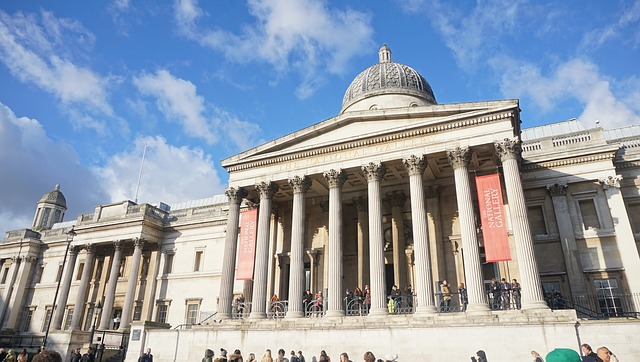National Gallery

The National Gallery owes its creation to King George IV, who wanted to create an art museum in London on a par with the Louvre. Today, it is one of the largest galleries in the world with an exhibition fund of more than 2000 paintings.
With its classical façade adorning the north side of Trafalgar Square in London, the National Gallery of the United Kingdom has one of the largest collections of Western paintings in the world.
The works on display at the National Gallery cover the 13th and 19th centuries in Western Europe. Here you will see works by Botticelli, Titian, Leonardo da Vinci, Michelangelo, Rubens, Rembrandt, Turner, Renoir, Van Gogh and, of course, great English artists such as Gainsborough and Turner. As well as seeing paintings, you can listen to lectures on art, which take place regularly in the gallery, and attend drawing classes.
History
The first paintings appeared in 1824 with the purchase of the collection of John Julius Argenstein, a London banker, and his mansion, affecting the works until a more suitable location was built. In 1831, the British Parliament gave its approval for the construction of a large building in Trafalgar Square, one of the most important squares in the city, and it was opened in 1838.
Opened on 10 May 1824, it actually began in 1823, when George IV’s Prime Minister, Lord Liverpool, decided to accept an offer to acquire the art collection that wealthy dealer John Julius Angerstein, the actual founder of Lloyds, had amassed. Behind the idea, in fact, was the powerful President of the Royal Academy and painter to the King, Sir Thomas Lawrence. It is his painting, dated 1827, in which Lord Liverpool is shown, in a magnificent pose and with a resolute gaze, holding up the rolled-up paper documents on which appears the inscription “National Gallery”.
The National Gallery is an exception among the great European state museums: unlike the Louvre in Paris, the Uffizzi in Florence, the Kunsthistorisches in Vienna or the Prado in Madrid, which were built on the basis of royal or princely collections, in London it was merchants and passionate collectors who imagined a museum to disseminate and share the taste for works of art with the general public. The result of the culture of the English merchant upper class, the Pinacoteca began to buy masterpieces from its foundation, without a well-defined policy, but with the flair of the collector and the knowledge of its directors.
When the Pall Mall headquarters became insufficient to accommodate new acquisitions, a new permanent headquarters was built in 1838 on the north side of Trafalgar Square: an imposing building designed by William Wilkins, a competent but uncreative architect, in the austere monumental style of the facade that we still see today. It was Queen Victoria who, a year after her accession to the throne in 1838, opened the new National Gallery, anticipating the interest in ancient and modern painting of Prince Albert, whom she married in 1840, and paving the way for the Crown’s new cultural policy.
Video
It will take you an hour to 2 hours to get an overview of all the paintings. And how to familiarize yourself with the exhibition, you need at least half a day. Although you don’t have to wait in line for tickets, we recommend that you plan your visit in the morning to avoid an influx of visitors.
The gallery has a café and bar where you can dine or relax after your visit. The gift shop sells high quality prints of all the paintings on display in the gallery.
Opening Hours
Every day from 10am to 6pm. Fridays from 10:00 to 21:00. It is closed on 1 January and between 24 and 26 December. Last admission at 5:55 p.m. Admission is free
How to get to the National Gallery
The address of the museum is as follows: Trafalgar Square, London, WC2N 5DN. The nearest tube station is Charing Cross and Leicester Square. There are also several buses to the Centre.
https://www.nationalgallery.org.uk/
https://goo.gl/maps/7d9SVSkWCfYWa5287
